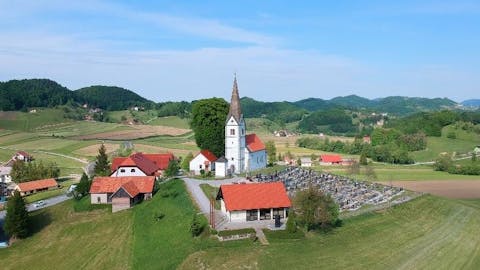
Žetale Municipality
Church of St. Mihael
In the middle of the Žetale basin, which was formed by tectonic shifts, the parish church of St. Mihael rises on a hill. In the mid-15th century, there was a clustered settlement of the same name — “Mihelsdorf” or “Miheldorf,” meaning Mihael’s village. The church consists of three main architectural parts: the bell tower, the nave, and the presbytery. Their differences show that the church was not built all at once, but rather developed in several construction phases. It is difficult to determine exactly when the church was built, since from the surviving fragment of a purchase document from 1298 it is unclear whether Hartnid of Ptuj bought the village with or without an already existing church. Given that the church is dedicated to St. Mihael, it is even possible that it stood before the first recorded mention of the village of Žetale — probably on a site that had been a pagan sanctuary before the spread of Christianity.
The current stone structure is generally dated to 1450, an inscription found on the wall of the presbytery likely marking the completion of part of the church, most probably the presbytery itself. The Gothic appearance of the church was repeatedly altered and restored in the centuries following its desecration and devastation by the Turks. From 1532 — after Sultan Suleiman’s destructive campaign toward Vienna — until 1622, the church was so desecrated that no liturgical services were held there. During that period, the church underwent thorough renovation: the nave was probably extended to its current length, a bell tower was built, and a baptismal font installed, as indicated by the inscription bearing the year 1623. During a later major reconstruction, the nave was raised and vaulted, and large windows were added, giving it its current Baroque character.
According to the visitation records of Archbishop Karl Mihael Count von Attems of Gorizia, the church once had five altars, of which three remain today. The main altar is dedicated to St. Mihael. Of the Baroque altar described by Archbishop Attems, only the central figure has survived; the side altars dedicated to St. Katarina and the Presentation of the Devica Marija (Candlemas) still stand. The removed altar of St. Anton once stood where the grotto of Our Lady of Lourdes is now located, and the altar of the Holy Eucharist once stood by the north wall of the nave, though the date of its removal is unknown. The pulpit, made of wood in Baroque style, stands on the north side of the nave. The church of St. Mihael is further adorned with paintings on the nave vault and used pipe organs from the Netherlands, which were reworked and installed by Anton Jenko from Šentvid near Ljubljana.